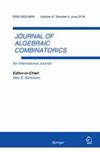Saturating systems and the rank-metric covering radius
IF 0.9
3区 数学
Q3 MATHEMATICS
引用次数: 1
Abstract
Abstract We introduce the concept of a rank-saturating system and outline its correspondence to a rank-metric code with a given covering radius. We consider the problem of finding the value of $$s_{q^m/q}(k,\rho )$$饱和系统和等级-度量覆盖半径
摘要引入了秩饱和系统的概念,并概述了它与给定覆盖半径的秩度量码的对应关系。我们考虑寻找$$s_{q^m/q}(k,\rho )$$ s q m / q (k, ρ)的值的问题,它是$$\mathbb {F}_{q^m}^k$$ F q m k中秩- $$\rho $$ ρ -饱和的q -系统的最小$$\mathbb {F}_q$$ F q -维。这相当于秩度量中的覆盖问题。我们得到了$$s_{q^m/q}(k,\rho )$$ s q m / q (k, ρ)的上界和下界,并对k和$$\rho $$ ρ的某些值进行了计算。我们给出了秩- $$\rho $$ ρ -饱和系统的构造。
本文章由计算机程序翻译,如有差异,请以英文原文为准。
求助全文
约1分钟内获得全文
求助全文
来源期刊
CiteScore
1.50
自引率
12.50%
发文量
94
审稿时长
6-12 weeks
期刊介绍:
The Journal of Algebraic Combinatorics provides a single forum for papers on algebraic combinatorics which, at present, are distributed throughout a number of journals. Within the last decade or so, algebraic combinatorics has evolved into a mature, established and identifiable area of mathematics. Research contributions in the field are increasingly seen to have substantial links with other areas of mathematics.
The journal publishes papers in which combinatorics and algebra interact in a significant and interesting fashion. This interaction might occur through the study of combinatorial structures using algebraic methods, or the application of combinatorial methods to algebraic problems.

 求助内容:
求助内容: 应助结果提醒方式:
应助结果提醒方式:


